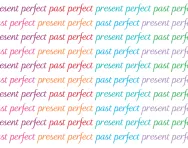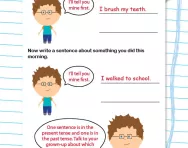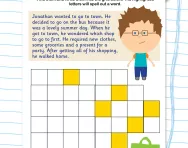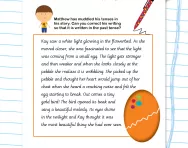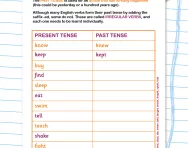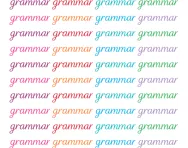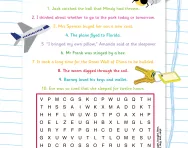TheSchoolRun.com closure date
As we informed you a few months ago, TheSchoolRun has had to make the difficult decision to close due to financial pressures and the company has now ceased trading. We had hoped to keep our content available through a partnership with another educational provider, but this provider has since withdrawn from the agreement.
As a result, we now have to permanently close TheSchoolRun.com. However, to give subscribers time to download any content they’d like to keep, we will keep the website open until 31st July 2025. After this date, the site will be taken down and there will be no further access to any resources. We strongly encourage you to download and save any resources you think you may want to use in the future.
In particular, we suggest downloading:
- Learning packs
- All the worksheets from the 11+ programme, if you are following this with your child
- Complete Learning Journey programmes (the packs below include all 40 worksheets for each programme)
You should already have received 16 primary school eBooks (worth £108.84) to download and keep. If you haven’t received these, please contact us at [email protected] before 31st July 2025, and we will send them to you.
We are very sorry that there is no way to continue offering access to resources and sincerely apologise for the inconvenience caused.
What is verb tense?
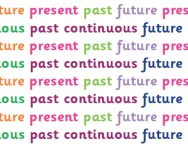
What is verb tense?
Verbs are words which express actions. The tense of a verb tells us the time when the action took place, in the past, the present or the future.
Identifying verb tenses
There are three main tenses: present, past and future.
These sentences are written in the present tense:
- I walk into the monster's cave.
- I am walking into the monster's cave.
The present tense is made up of simple present / present simple (actions which happen regularly), present continuous / present progressive (actions which are taking place now) and present perfect (actions which are now completed).
These are examples of sentences written in the past tense:
- I walked into the monster's cave.
- I was walking into the monster's cave.
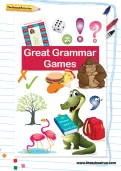
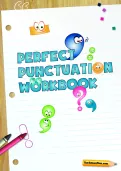
Download Fantastic FREE Grammar Resources!
- Perfect Punctuation Workbook
- Great Grammar Games Pack
- PLUS 100s of other grammar resources
The past tense is made up of simple past / past simple (actions which took place at a specific time and are now finished), past continuous / past progressive (Actions which took place in the past over a period of time) and past perfect (actions which were completed by a particular point in the past).
These sentences are written in the future tense:
- I will walk into the monster's cave.
- I will be walking into the monster's cave.
The future tense is made up of simple future / future simple (actions which will take place in the future), future continuous / future progressive (actions which will take place in the future over a period of time) and future perfect (actions which will be completed by a particular point in the future).
Children will learn to distinguish between verb tenses in KS2. They will also look at the subjunctive in Year 6, and be introduced to irregular verbs.
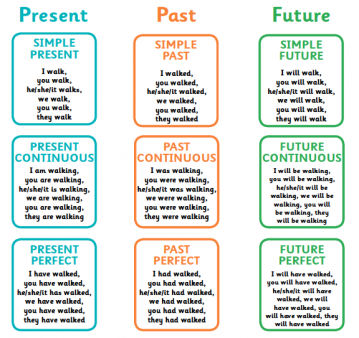
Using verb tenses correctly in KS1 and KS2
When a child is writing a story, they need to make sure that whether it is written in the past or present tense, the tense is kept consistent throughout.
Children learn a lot about verb tenses through listening, speaking and reading. One way a teacher might help a child with their tenses is to underline verbs that need to be changed so that a story they have written has a consistent tense throughout, for example:
I woke up on a sunny morning and ran excitedly into the kitchen. My mum was making me pancakes, my favourite! She laid a pancake on my plate and I picked up the maple syrup and squeezed this all over the top. I roll up the pancake and stuff it in my mouth: it is delicious!
Here a child would be expected to read through the start of the story and think about which tense the story was written in. They would then need to change these underlined verbs to 'rolled', 'stuffed' and 'was' to keep the story consistently in the past tense.
Children will be reminded about tenses when they write fiction and non-fiction texts.
When they write a fiction text, they will need to remember to keep the tense consistent (that is, if they start writing in the past tense they need to stick to that throughout the story).
When writing non-fiction texts, they need to remember to keep to the tense shown in the texts they have studied.
- Present tense would usually be used for instructions, information texts, reports and explanations.
- Past tense would usually be used for recounts, biographies and autobiographies.
- Persuasive writing, journalistic writing and argument texts could be a mix of tenses (for example: an argument text might give an argument in the present tense, backed up by a fact in the past tense).

